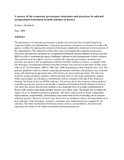| dc.description.abstract | The prominence of corporate governance in public discourse has been inspired largely by
corporate failures and globalisation. Corporate governance structures are intended to reduce the
agency conflicts by aligning the interests of the many stakeholders interested in the resources of
the organizations.
The objective of this study was to investigate the corporate governance structures and practices
instituted by occupational retirement benefit schemes in Kenya and the RBA in a bid to
surmount the agency challenges inherent in the management of these schemes. This research
used descriptive survey to explore the corporate governance structures and practices prevalent in
the occupational retirement benefits schemes in Kenya.
A sample of the top 40 largest occupational retirement benefits schemes was selected on the
basis of their asset value as at 31st December, 2008 or 30th June, 2008 depending on their
financial year- end. The primary qualitative data on scheme corporate governance structures and
practices was collected using self-administered questionnaires with closed and open-ended
questions.
The data was analyzed using descriptive statistics. Statistical tools such as, the mean,
proportions, graphs, tables, percentages, and frequency distributions will be computed with aid
of the Statistical Package for Social Sciences (SPSS) software.
The survey shows the existence of best practice corporate governance practices among the
occupational retirement benefit schemes in Kenya. The study has shown that the trust method is
the dominant form of scheme establishment in Kenya with scheme rules being updated at least
every three years. The board size is within the range of 6 to 12 members and meets quarterly.
The other criteria such as board composition, representation, responsibility, performance
assessment and record of meetings are in tandem with best practice. However in most cases there
were no minimum criteria and term limits set in most schemes. Fund managers, actuaries,
custodians and auditors had been engaged by all schemes.
The other mechanism of internal control, redress, accountability, disclosure and reporting were
found to be within acceptable international practice. | en |


